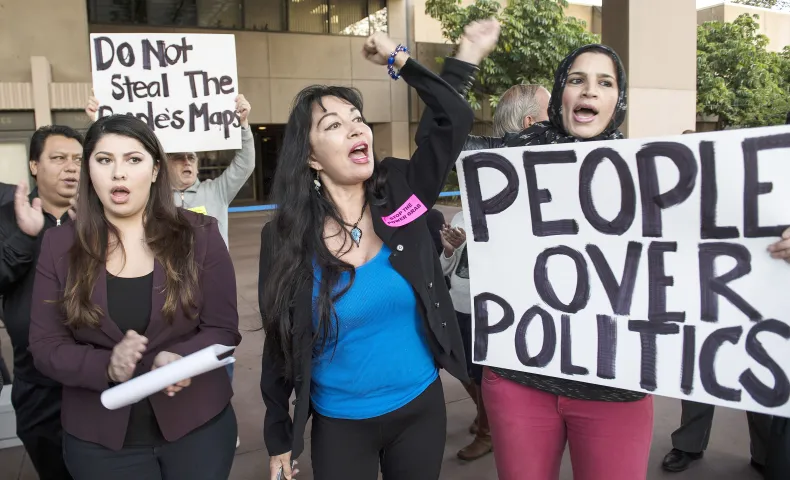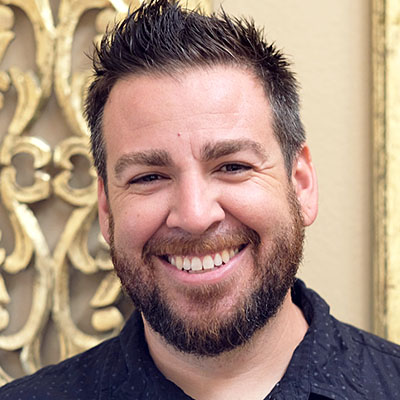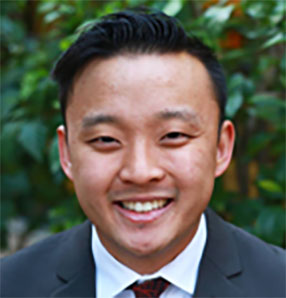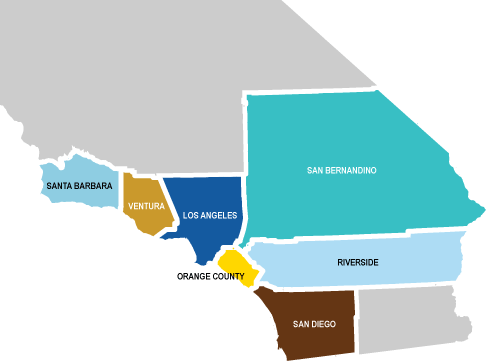 Photo by Michael Fernandez
Photo by Michael Fernandez
Mapping the Way to Power
Every 10 years, political maps across the United States are redrawn based on the results of the U.S. census. It’s a critical process for making sure all communities have fair representation in government and elections. And in a number of California counties, it’s a process that in 2021 and 2022 delivered historic wins for underrepresented communities, including many new political districts where Latino residents are a majority of voters.
As part of the Haas, Jr. Fund’s broader efforts to strengthen democracy, we’ve been partnering with a number of regional coalitions working on redistricting issues in California. We spoke with two of the leaders of these efforts—Michael Gomez Daly, executive director of Inland Empowerment, and Jonathan Paik (J.P.), executive director of the Orange County Civic Engagement Table—about why redistricting is so important, what their local coalitions accomplished, and the work that lies ahead.
Why Redistricting Is So Important
 Michael Gomez Daly (Inland Empowerment): Riverside and San Bernardino counties have a long history of systemic racism. Redistricting is one of the few chances we have to really change the systems that have kept immigrants and people of color from having a fair say in government.
Michael Gomez Daly (Inland Empowerment): Riverside and San Bernardino counties have a long history of systemic racism. Redistricting is one of the few chances we have to really change the systems that have kept immigrants and people of color from having a fair say in government.
 Jonathan Paik (Orange County Civic Engagement Table): Orange County is a similar story. The demographics of the county have been changing fast, but political representation has not. And over the years our communities have faced a lot of racism and targeting. That’s why we built a multiracial coalition to make sure the community was part of the redistricting process. For too long, people in power have used this process to dilute the voices and the votes of impacted communities.
Jonathan Paik (Orange County Civic Engagement Table): Orange County is a similar story. The demographics of the county have been changing fast, but political representation has not. And over the years our communities have faced a lot of racism and targeting. That’s why we built a multiracial coalition to make sure the community was part of the redistricting process. For too long, people in power have used this process to dilute the voices and the votes of impacted communities.
Headline Redistricting Wins
Michael: We advocated for seven Voting Rights Act-compliant state assembly districts (districts where people of color are a majority of eligible voters)—and we got all seven. This is the first time in history where we have an opportunity for truly good representation for Latino residents. We also now have Latino-majority districts for Congress and the state senate. It’s a huge opportunity for communities that until now have been largely shut out of politics and government.
J.P.: We now have the first Voting Rights Act-compliant local district in Orange County, along with some of the most diverse U.S. congressional districts in the country. In one congressional district alone, 20 percent of the eligible voters are foreign-born. That gives real power and influence to those communities, and it also creates exciting opportunities to build multiracial and multi-ethnic solidarity across issues.

Orange, San Bernardino and Riverside Counties in Focus
What the Work Looked Like
J.P.: The People’s Redistricting Alliance is a network of 16 community-based organizations from all across Orange County. These groups historically have not worked together. It’s everyone from the Arab American Civic Council to the South Asian Network. These are groups that represent some of the most impacted communities in the county, and they co-created a process that got a broad group of residents and community partners engaged in the work of developing maps and speaking up for their interests.
Michael: In San Bernardino and Riverside counties, we had a great coalition of groups working on the 2020 census. It’s a mix of social service and community-based organizations working with Latino residents and other communities. When redistricting came around, we just kept that coalition going, and people really stepped up. In Riverside, the board of supervisors was considering 57 different maps for supervisor districts, and the map developed by our coalition was one of the final two they were deciding on. It was a huge win just to get that far. Even though our map wasn’t selected, it showed the power and influence of this coalition. It’s the work of these groups that made the difference in winning our Latino-majority districts.
Challenges Along the Way
J.P.: Bringing so many stakeholders together behind one unified map is not easy. Historically, there have been wedges between and across our communities that reemerge time and again. And so our goal was not only to make sure all interests were included in the maps but also to help people see why it’s so important to organize together.
Another big challenge was that this was the first time many of our local governments had to go through a redistricting process (see text box). So there wasn’t a lot of infrastructure in place to support all the work of getting people involved in the process.
Michael: For us the biggest challenge was the narrative that somehow community groups like the members of our coalition are a special interest. The fact is, these are groups that represent communities that historically have been left out of processes like this, groups that need and deserve better representation. They need to be heard for the process to be legitimate. And what Jonathan said about infrastructure was true for us too. Just developing the knowledge and skills and the outside experts to help develop maps and get community input and all the rest—that takes time and it’s not something you can build overnight.
What’s Next
J.P.: After redistricting, the next challenge is preparing for elections with these new districts. Redistricting opens up opportunities for new political leaders who might never have imagined themselves running for office; now they have a real shot at representing their communities. And so there’s work to do in helping those leaders rise up and also in educating voters about their new districts and the new opportunities they have to exercise their power and voice. We also are exploring ways to keep our coalition partners together to work on common issues on a continuing basis.
Michael: We are doing the same things and continuing our partnerships across the region. And one other thing we’re trying to do is educate elected officials about their new districts. These politicians have been working under the previous maps for a decade, and now the demographics and the priorities of their constituencies have changed, sometimes in dramatic ways. So that gives us a chance to lift up what our communities really care about and what they want from their elected leaders on issues from criminal justice to education.
Lessons for Philanthropy
Michael: A lot of funders got involved in 2020 census work in California and nationwide. But philanthropy really didn’t invest as much in redistricting, which is just as important if you want to ensure that people are counted and have a voice in things. Our census funders allowed us to carry over some of that funding to our redistricting work, and that was great. But as a whole, I think philanthropy could do a lot more to help communities get involved in this process.
J.P.: If we look ahead to the 2030 census and redistricting, I just hope we aren’t making the necessary investments one or two years ahead of time. We need a generational investment starting now to build the bench of local leaders and researchers and others who can help make sure these processes deliver real and lasting gains for the communities we all care about.